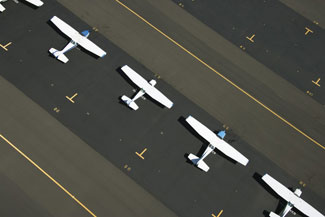Programs
General Aviation
Security Advisories | Security Initiatives
Secure Fixed Base Operator Program (SFBOP)

On December 31, 2007, TSA launched, with industry partner Signature Flight Support, the Secure Fixed Base Operator Program (SFBOP) at Anchorage, Alaska, and Shannon, Ireland. The program is a proof of concept, public-private sector partnership program that will allow FBOs to check passenger and crew identification against manifests or eAPIS filings for positive identification of passengers and crew onboard general aviation aircraft. Working in close coordination with industry partners, TSA believes that this security initiative will provide additional security for flights inbound to the United States. The agency is encouraged by the public/private sector partnership to improve security. The broader application of such programs will provide robust security while maintaining operational flexibility for general aviation operators.
Click here for SFBOP Frequently Asked Questions.
DCA Access Standard Security Program (DASSP)
TSA's Interim Final Rule (PDF 1.7 MB), which was developed in coordination with other Department of Homeland Security agencies and the Department of Defense, takes into consideration the special security needs of Washington Reagan National Airport (DCA). Under TSA's security plan, 48 flights in and out of DCA will be allowed each day. All aircraft will be required to meet the security measures set forth in the DCA Access Standard Security Program (DASSP).
Twelve-Five Standard Security Program (TFSSP)
The Twelve-Five Standard Security Program requires that certain aircraft operators using aircraft with a maximum certificated take-off weight (MTOW) of 12,500 pounds or more carry out a security program. Operators were required to be in compliance with the program effective April 1, 2003.
Private Charter Standard Security Program (PCSSP)
The Private Charter Standard Security Program is similar to the TFSSP but adds additional requirements for aircraft operators using aircraft with a MTOW of greater than 45,500 kg (100,309.3 pounds) or with a seating configuration of 61 or more. Operators were required to be in compliance with the program effective April 1, 2003.
Maryland-Three Program
The Maryland-Three Program allows properly vetted private pilots to fly to, from, or between the three general aviation airports closest to the National Capital Region. These airports are collectively known as the "Maryland Three" airports, and include College Park Airport (CGS), Potomac Airfield (VKX) and Hyde Executive Field (W32.) These airports are all within the Washington, DC Air Defense Identification Zone (ADIZ) and the Washington, D.C. Flight Restricted Zone (FRZ.)
The Maryland-Three Program allows properly vetted private pilots to fly to, from, or between the three general aviation airports closest to the National Capital Region.
Download Plug-in
Some of the links on this page require a plug-in to view them, which are available below.



